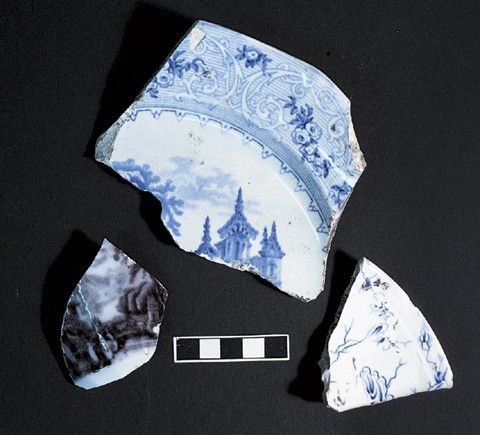
Undecorated ironstone forms from the Wood deposit, Tunstall, ca. 1850. Scale is in centimeters. (All illustrations courtesy Potteries Museum & Art Gallery.)

Printed earthenwares from the Wood deposit. Left to right: Peruvian, Geneva, and Marble; Tunstall, ca. 1845– 1850. Scale is in centimeters.

Painted earthenwares from the Wood deposit, Tunstall, ca. 1847–1850. Scale is in centimeters.

Fused earthenware dishes from the W.H. Grindley deposit, undecorated and with Lorne (center) and Beaufort printed designs; Tunstall, ca. 1847–1850.

Printed earthenwares from the Johnson Brothers deposit. Left to right: Richmond and St. Louis; Tunstall, ca. 1900–1912. Scale is in centimeters.
Recent archaeological work in Tunstall has unearthed significant quantities of ceramics produced for the North American export market in the mid-nineteenth and early twentieth centuries. Waste dumps have been found which are attributable to three north Staffordshire manufacturers known to have had a sizeable interest in this trade. These finds are briey discussed below.
Work on the demolition of the Woodland Works in Tunstall generated a pottery waste assemblage of John Wedg Wood, occupant of the factory from 1845 to 1857. Undecorated white granite ironstone-types, the ubiquitous American export ware of the mid-nineteenth century, dominate the assemblage and appear in a range of uted tea and tableware forms (fig. 1).
Transfer-printed wares are also present, with blue and ow-mulberry designs such as Geneva, Marble, and Peruvian, as are examples of factory-made slipware, shell-edged, polychrome painted and sponge-decorated earthenware (figs. 2, 3). Registration marks indicate a production date for the sherds of 1847 to 1850. Wood is notable in that he was one of the few local manufacturers whose output was almost totally devoted to supplying retail and wholesale outlets in North America.[1] Consequently, the wares from his factory group offer an important insight into the typical ceramic wants of the North American consumer in the middle years of the nineteenth century.
Up until the last few years, there has been a paucity of excavated evidence for the late nineteenth- and early twentieth-century production of American export wares. However, the recent discovery of two waste assemblages of W.H. Grindley & Co. and the firm of Johnson Brothers has helped to advance our understanding of this important, but often neglected period in the history of north Staffordshire’s export trade with the United States. Both manufacturers ranked amongst the Potteries’ “great ‘American’ firms” of the first quarter of the twentieth century, with a high percentage of either concern’s output geared to supplying good quality durable earthenwares to a large North American consumer base.[2]
As with the Wood finds, the W. H. Grindley & Co. material was recovered from the site of the Woodland Works, home to the firm from 1891 until recent years. The finds consist of undecorated and transfer-printed earthenwares in a range of elaborately molded tea and tableware forms. The transfer-printed wares exhibit a number of ow-blue designs such as Beaufort, Portman, Melbourne, Syria, Keele, and Lorne (fig. 4). The styles of printed marks used suggest that the wares were made between 1915 and 1925.[3]
The Johnson Brothers assemblage is roughly contemporary with the Grindley material, dating to between 1900 and 1912, and was probably produced at the Alexandra Works, Tunstall, a short distance from where the sherds were found.[4] The two groups have clear similarities, with the Johnson Brothers wares displaying the same range of molded forms, both with and without printed decoration, that are obvious in the Grindley assemblage. Flow-blue patterns are once again prominent among the printed wares, with designs such as Richmond and St. Louis (fig. 5). The undecorated forms are restricted to wares of an ironstone-type body.
Jonathan Goodwin,
The Potteries Museum & Art Gallery
Bethesda Street
Hanley, Stoke-on-Trent
<jon.goodwin@stoke.gov.uk>
Neil Ewins, “Supplying the Present Wants of our Yankee Cousins: Staffordshire Ceramics and the American Market 1775–1880,” Journal of Ceramic History 15 (1997): 60–71.
G. W. Rhead and F. A. Rhead, Staffordshire Pots and Potters (London: Hutchinson & Co., 1906), pp. 313–14.
G. A. Godden, Encyclopaedia of British Pottery and Porcelain Marks (London: Barrie & Jenkins, 1991), p. 294.
Cartographic sources show the area in which the sherds were discovered as open waste ground between 1900 and, at the very latest, 1912, at which point the modern street was laid down. The Johnson Brothers material must have been dumped here during this twelve-year period.
